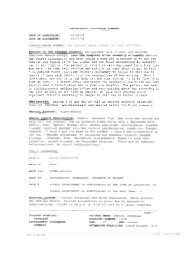C - Organized Mobbing
C - Organized Mobbing
C - Organized Mobbing
Create successful ePaper yourself
Turn your PDF publications into a flip-book with our unique Google optimized e-Paper software.
498 CHAPTER NINE<br />
the simplest variant, these were prebriefed secret police cadets, in<br />
more cog.<br />
plex ones (involving more coordinating preparations), Comrad<br />
es from<br />
local party organizations were involved. Well-targeted recognition the<br />
alSc<br />
be employed to amplify opposing opinions between fractions. 1, th<br />
group<br />
splitting 1 discussed in the last chapter, selective recognition was<br />
mplO?ed.<br />
In particularly disturbing cases, children were mobilized through Pressures<br />
in school to influence their parents in a more conformist direction.<br />
Secret informants also deliberatelyplanted understandings that were likelv<br />
to have strong resonances with preexisting, potentially destructive beliefs ,<br />
Or<br />
desires. mis was the idea behind combining existing with new information<br />
the validity of the old in combination with lending<br />
the new. In this way, secret informants were used to feed ambitions, misgivings,<br />
or desires that could lead to friction; they were amplifying mistrust ,,<br />
well as aesthetic and moral discomfort of one member with another.<br />
mors were planted, most commonly about a person's link to the secret police,<br />
which was building on the group's hunches that they probably had moles<br />
in their midst. Another tried and tested means of planting understan&<br />
used especially against Protestant ministers, was spreading lies about persons'<br />
sexual life (e.g., suggesting infidelities, dissipation, or perversion) ,,<br />
about inappropriate levels of alcohol con~umption. These were often backed<br />
by planted corroborating circumstantial evidence, such as retouched photographs,<br />
sexual toys, or strategically placed liquor bottles. The effect the Stasi<br />
aimed at with these measure was the destruction of the targeted person's<br />
self-confidence by creating shame-saturated events andlor the erosion of<br />
this person's authority in the eyes of other network members, thus ultimately<br />
destroying the operability of the network by depriving it of nodal figures.<br />
Manipulating corroboration was also employed as a tool of decomposition.<br />
Most notably, the secret police managed to prevent people from obtaining<br />
a desired job or place at an educational institution. It arranged for<br />
people to be fired or dismissed. Stasi also influenced performance reviews,<br />
grading, and decisions to send somebody to continuing education or to an<br />
international conference. Decisions to have a manuscript for publication<br />
accepted or rejected or to award a particular research project to a articular<br />
person, could all be influenced by the Stasi in the interest of molding the<br />
targeted person's understandings. Where such measures caught their targets<br />
unaware of their entanglement in the Stasi's web of machination, they<br />
were meant to confirm doubt about their own abilities. Where people knew<br />
who was responsible for their misfortune, the "organization of failure" was<br />
meant to shape people's assessment of risk involved in ~arty-critical activities.<br />
With the same intention, the Stasi often flaunted its presence in front





